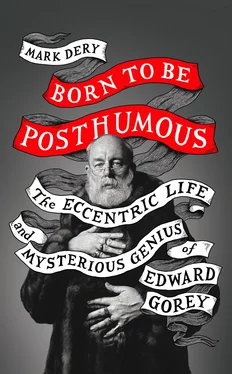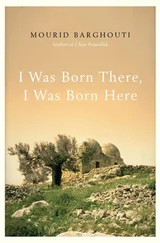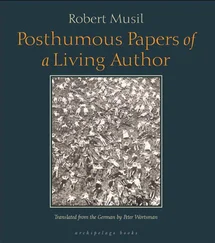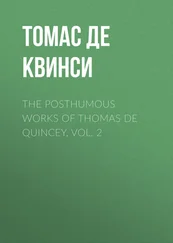Ted had girls on the brain in those days, apparently: in a December 1940 column, the Parker Weekly ’s inquiring reporter quotes Gorey’s response to the question, “What do you look forward to in 1941?”
Ted Gorey:
Better marks in school.
More pretty girls.
An increase in allowance. More pretty girls.
Better food in the lunchroom. More pretty girls. 66
Nothing odd in that for a heteronormative, hormone-fueled fifteen-year-old boy, but a bit difficult to reconcile with the Gorey we know, who claimed to be “reasonably undersexed or something.” 67
His insistent interest in pretty girls notwithstanding, Gorey was consumed, in school and out of it, by his passion for the arts. He’s clear on that point in his application for a Harvard College National Scholarship, submitted in January of his senior year at Parker: “My main interests lie in the field of Art.”
I do a great deal of drawing and painting myself and I am very much interested in Art. I attend exhibits at the Chicago Art Institute and other galleries regularly. Music interests me a great deal also. I go to the Chicago Symphony Orchestra concerts fairly often during the year. I like the Ballet very much and try to see it as many times as I can when there is a company in Chicago. The legitimate theater is one of the things I enjoy and I see most of the plays which come to Chicago. I go to the movies a lot and try to see all of the foreign movies which come here. 68
To that wide-ranging cultural diet add books devoured by the shelfload. A good number of the titles he listed on his scholarship application were mysteries (“my favorite form of reading”): The Thirty-Nine Steps by John Buchan, books by Mary Roberts Rinehart, Ngaio Marsh, Rex Stout, Dorothy L. Sayers, G. K. Chesterton, and of course Agatha Christie—and true-crime anthologies, too, such as William Roughead’s Murderer’s Companion , a collection of deliciously macabre retellings of nineteenth-century crimes, and Edmund Pearson’s Studies in Murder .
Not that Gorey subsisted on pulp alone. When the application asks him to list “all the books which you have read during the past twelve months,” he’s only too happy to inventory his prodigious intake of highbrow lit. “I am attaching an extra sheet for this purpose,” he notes, matter-of-factly, “as this space is not large enough.” The epic catalog that follows includes Homer’s Iliad and Odyssey , Plato’s Republic , works by Herodotus and Thucydides, Aristotle’s Poetics , Complete Greek Drama , the Oxford Book of English Verse , Joyce’s Ulysses , and Koestler’s Darkness at Noon , along with fizzier fare such as S. J. Perelman, Dorothy Parker, P. G. Wodehouse, and Robert Benchley. This is just a smattering of the sixty-nine titles he reels off, apart from the scads of mysteries he mentions by author only, too many to list. Sensing, perhaps, that the sheer number of books he claims to have read in a year, let alone their intellectual heft, might raise a skeptical eyebrow, he hastens to add, “I would be willing to be asked general questions on any of these books.”
Reading insatiably, exploring Chicago’s cultural offerings with gusto, Gorey was refining the approach that would make him a species of one as an artist. Consciously or not, he was stuffing the curiosity cabinet of his mind with ideas and images (“I keep thinking, how can I use that?”) that would one day reappear, reimagined, in his art or writing. 69
His forays into Chicago’s art scene undoubtedly acquainted him with what would turn out to be another of his great passions, surrealism. At her eponymous gallery, the pioneering dealer and curator Katharine Kuh showed Miró, Man Ray, and the surrealist-influenced Mexican modernist Rufino Tamayo, all in ’38, Gorey’s first year at Parker. Improbably enough, the town that loathed modernism—the Tribune poured scorn on Kuh, and Sanity in Art protested her shows—proved surprisingly congenial to surrealism. The Arts Club, a private sanctum for the city’s moneyed elite whose exhibitions were nonetheless open to the public, introduced Chicagoans to Salvador Dalí in a 1941 show and, in ’42, to André Masson and Max Ernst; Gorey could easily have seen these shows.
Truth be known, though, he never had much use for surrealist art, beyond Ernst’s collage novels and Magritte, who he once claimed was one of his three favorite painters. (Francis Bacon and Balthus were the other two.) Nonetheless, he was profoundly influenced by surrealist ideas. Asked, “Do you view yourself in the Surrealist tradition?” he said, “Yes. That philosophy appeals to me. I mean that is my philosophy if I have one, certainly in the literary way.” 70
In his books, he often employs surrealism’s dream logic, as in the non sequitur causality of The Object-Lesson , in which an umbrella disengages itself “from the shrubbery, causing those nearby to recollect the miseries of childhood” and it becomes apparent, “despite the lack of library paste,” that something has happened to the vicar. Sometimes he makes use of Magritte’s hallucinatory conjunctions, as in The Prune People , in which prim, proper Edwardians with prunes for heads go matter-of-factly about their affairs. Or he imagines the inner lives of objects—a very surrealist thing to do—as in Les Passementeries Horribles , in which hapless Edwardians are menaced by ornamental tassels grown to monstrous size.
But even when he isn’t drawing on surrealism so obviously, his stories are often thick with that atmosphere of somnambulistic strangeness that is a surrealist trademark, as in the eerie, wordless The West Wing , a procession of frozen moments set in the usual Victorian-Edwardian mansion, in the usual crepuscular gloom, where everything—the enigmatic package tightly tied with twine in one room, the wave-ruffled water rising halfway up the walls in another, the nude man standing with his back to us on a balcony—manages to seem simultaneously like a clue in an Agatha Christie mystery and a symbol from Magritte’s The Key to Dreams .
Gorey was a surrealist’s surrealist: he understood that surrealism wasn’t just the bourgeoisie’s idea of dream imagery—limp watches, lobster telephones, the guy with the floating apple obscuring his face. It was meant to be an applied philosophy—a way of looking at everyday life, a way of being in the world. “What appeals to me most is an idea expressed by [the surrealist poet Paul] Éluard,” said Gorey. “He has a line about there being another world, but it’s in this one. And [the surrealist turned experimental novelist] Raymond Queneau said the world is not what it seems—but it isn’t anything else, either. Those two ideas are the bedrock of my approach.” 71
He even went so far as to suggest that life, with its random juxtapositions and meaningless events, could be seen as a surrealist collage. “I tend to think life is pastiche,” he said, adding drolly, “I’m not sure what it’s a pastiche of—we haven’t found out yet.”
It was surrealism that led Gorey to what would become an overmastering passion: the ballet. In January of 1940, “I went off by myself to see the Ballet Russe de Monte Carlo do Bacchanale ,” he recalled, “because of its sets and costumes designed by Salvador Dalí, who had been sprung on me by Life magazine.” 72(At the age of fourteen, Gorey thought Dalí “was the cat’s ass.”) 73
Bacchanale , unfortunately, was a letdown. But if Ted wasn’t swooning over Dalí’s decor—the dancers emerged from a ragged hole in the breast of the gargantuan swan in the backdrop—or his strenuously outrageous costumes (one dancer wore a fish head), he was bowled over by the ballerina who danced the role of Lola Montez in “enormous gold lamé bloomers encircled at their widest part by two rows of white teeth,” an appropriately surrealist getup that was the handiwork of the renowned costume maker Karinska. 74Gorey was entranced by Karinska’s creations; fifty-five years later, in his foreword to Costumes by Karinska , a book about her work, he rhapsodized about costumes “I have fondly remembered, some for over half a century,” such as “the satin and ruffled dresses for the cancan dancers in Gaîté Parisienne , whose combinations of colors I still think were the most gorgeous I ever saw.” 75
Читать дальше












